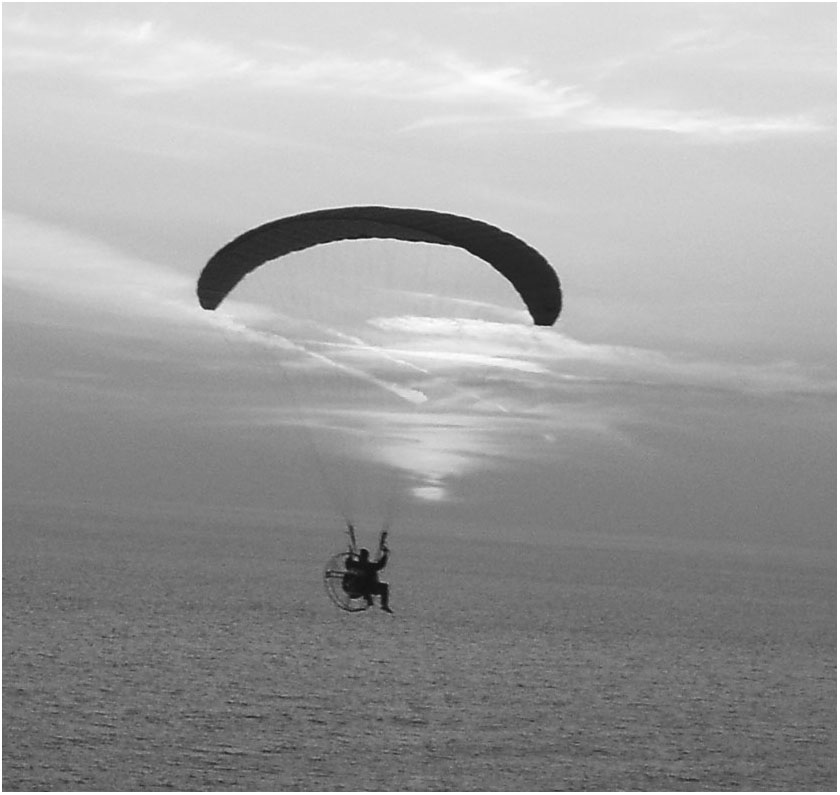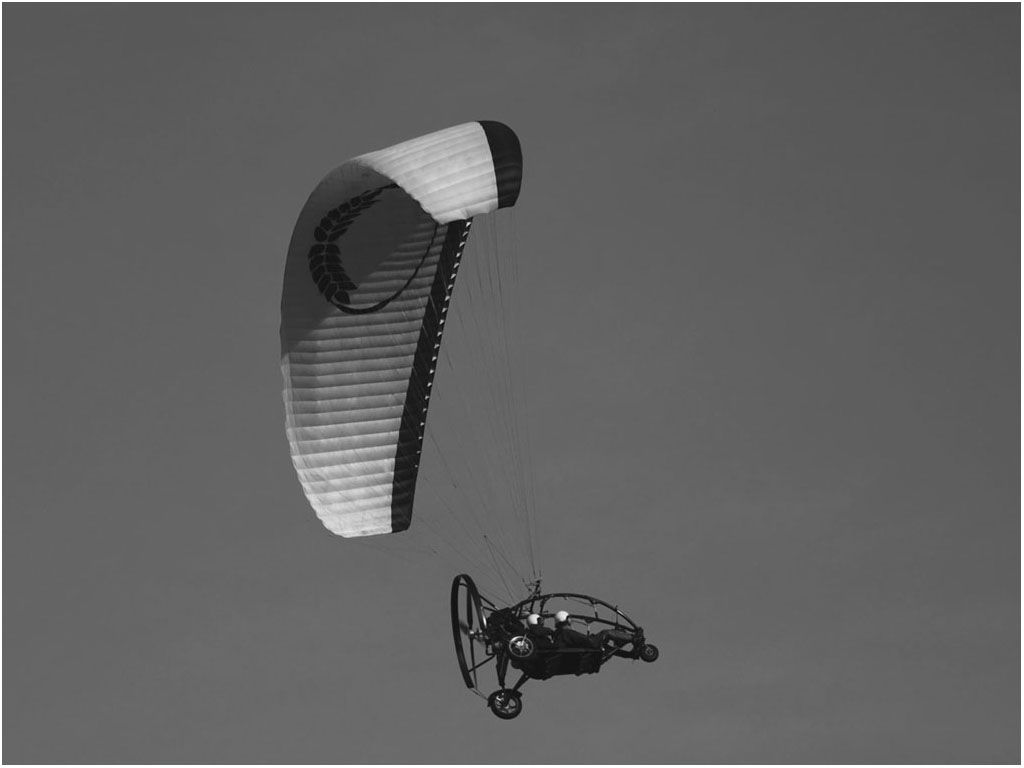

Vadim Petrakov/Shutterstock.com
We’ve discussed land travel and water travel. For some, taking flight might be an ideal escape from ground zero. Air travel is no longer reserved for the uber-wealthy. Small experimental flying machines are available for just a few thousand dollars. If weather permits, evacuating as the crow flies could be the fastest way out of Dodge.
However, unless one has made arrangements to launch a flying BOV directly from a backyard landing strip (or similar), this strategy must also involve a vehicle to transport one to the takeoff location. This, combined with the obvious drawbacks, including weather conditions and operation expertise makes choosing a flying BOV a very complicated decision. The extreme advantages are countered by extreme challenges and risks. Personally, when planning for a potential Bug Out, my strategy is to eliminate as much risk as possible. Choosing an aircraft of any kind as a primary BOV is just too risky for me. This is certainly not to say that it cannot be done and also not to say that it doesn’t make a good additional BOV option for those with the means to do so.
From private luxury jets to smaller bush planes, taking to the sky certainly has its advantages. I’m surprised each year at the number of pilots who fly to my courses in Indiana from out of state and land at a small airport nearby rather than drive. Fractional and shared ownership of planes makes piloting much more affordable and practical than owning a plane outright. A lot of pilots are just average Joes who build their own aircraft from kits for around the price of a traditional car. Gone are the days of needing a million dollars to own a plane. A Sport Pilot License can be earned by a seventeen-year-old with as little as twenty hours of training.
I’m reminded of several great survival movies (and even a Stephen King novel) where those with access to a plane were the only ones who made it out alive. Flying over clogged expressways or ground-level disasters could very well be a reality for some who own a Bug Out Plane. Short takeoff and landing (STOL) bush planes, like the Backcountry Super Cub, can land and take off in an insanely short distance on rugged terrain. Some nearly fly straight up like a helicopter. This allows for a tight takeoff in less-than-perfect conditions and a remote landing at a predetermined Bug Out Location far from urban reach. Backcountry planes can also be fitted with pontoons for water landings or skis for snow and ice landings. Is your BOL located on a remote backcountry lake? No problem! Planes offer a very unique solution to Bug Out travel.
Just as one traveling by vehicle should have a paper map and compass as a backup to electronic navigation, pilots should have a backup plan as well. This should include a series of landmarks chosen ahead of time that can help navigate to a Bug Out Landing Strip. It’s also important to identify several possible landing areas along the route, just in case an emergency landing is required.

Airplane Bug Out (istock.com/©Thunder)

Float plane (Gordon Bell/Shutterstock.com)
Travel Speed: Even small backcountry planes can cruise in excess of 120 mph. The Cessna Citation X can cruise at speeds up to 604 mph. Couple these speeds with straight-line travel and one can get from point A to B really fast.
Speed Away From Disaster: Assuming one can get to the plane and take off, the speed away from ground zero beats nearly any other BOV option.
Takeoff: Some backcountry bush planes can be in the air faster than most muscle cars can go from 0-60 mph. These short takeoff and landing (STOL) aircraft can easily land in remote Bug Out Locations and are designed specifically to do so.
Terrain: Some planes can be fitted with pontoons for water takeoffs/landings, skis for snow and ice takeoffs/landings, and large tundra wheels for uneven or sandy takeoffs/landings.
Avoid the Crowds: The sky will certainly be less crowded than the paved roads out of town.
Storage: Some smaller planes lack storage space, especially when it comes to extra passengers.
Fuel: Refueling could be nearly impossible during a large-scale chaotic disaster. Consider extra fuel storage on board the aircraft. A plane that uses auto gas versus aviation gas may be advantageous due to availability.
Weather: A Bug Out Plane could be completely useless if bad weather is the reason for a Bug Out.
Budget: Airplanes are an expensive BOV, regardless of which one you choose. They are expensive to purchase, store, maintain, and operate.
No-Fly Orders: It’s not uncommon during large-scale disasters, especially terrorist related, for the government to issue a regional or national “no-fly” order. Disobeying the order could result in severe consequences, including an F-16 on your tail.
Maintenance: Airplanes should be meticulously maintained after each and every use.
License: A pilot’s license is required to fly. This takes significant time and money to acquire.
Navigation: GPS may not be available. Be sure to have a series of visible landmarks chosen in advance to help guide you to a Bug Out Landing Strip.
Weight: All airplanes have weight limits for cargo. Be sure to know what they are. Cargo nets and ratchet straps should also be considered in order to keep cargo from shifting during flight.
Airport: Consider keeping the plane in smaller privately owned hangers and airports. It is likely that authorities will quickly shut down larger airports or that they will be a logistical nightmare to mitigate.
Noise: Landing in a remote airstrip may draw unwanted attention.
In the event of a complete collapse, it’s not hard to imagine the absence of GPS navigation, landing beacons, radar, or ground communications from Air Traffic Control. It is important for pilots to understand and abide by basic Visual Flight Rules (VFR), including flight altitude. In cases of limited visibility and poor communications, landings and takeoffs can become a deadly game of Russian roulette.
Helicopters and gyrocopters are unique in that they can get in and out of places where all other aircraft cannot. This is why most rescue operations and special ops teams use helicopters exclusively. Maneuverability in the air is also unparalleled.
If weather permits, I cannot think of a faster and more direct way out of a crowded city than by helicopter. Helicopters can deliver people and goods to extremely remote Bug Out Locations that may not be accessible by any other vehicle or even by foot.

Helicopters provide a quick escape (Ivan Cholakov/Shutterstock.com)
Takeoff and Landing: Helicopters can take off and land in very small areas.
Speed: Helicopters and many gyrocopters are very fast as compared to traveling by vehicle on land or water.
Maneuverability: Helicopters have the unique ability to maneuver within areas other aircraft cannot, such as tall buildings, forests, and mountains.
Training: Requires extensive training to operate.
License: A license is required to fly helicopters and gyrocopters.
Budget: Helicopters and gyrocopters are expensive to purchase, store, maintain, and operate.
Crash Landing: Helicopter emergency landings are incredibly dangerous.
Storage: Small helicopters and especially gyrocopters have very limited storage space.
No-Fly Orders: It’s not uncommon during large-scale disasters, especially terrorist related, for the government to issue a regional or national “no-fly” order. Disobeying the order could result in severe consequences, including an F-16 on your tail.
Maintenance: Helicopters and gyrocopters should be meticulously maintained after each and every use.
Navigation: GPS may not be available. Be sure to have a series of visible landmarks chosen in advance to help guide you to a Bug Out Landing Strip.
Weight: All helicopters and gyrocopters have weight limits for cargo. Be sure to know what they are. Cargo nets and ratchet straps should also be considered in order to keep cargo from shifting during flight.
Airport: It is likely that authorities will quickly shut down larger airports or that they will be a logistical nightmare to mitigate. A smaller, privately owned hanger and airport is a better choice.
Noise: Landing in a remote area may draw unwanted attention.
Most aircraft in this category are very sensitive when it comes to flying conditions and weather. I own a backpack-style powered paraglider. The photo above is of me flying over the ocean off the coast of Florida. In near perfect weather conditions, I suppose I could load a few extra survival supplies on board, but most of these smaller, single-manned flying machines are designed for recreational piloting. My paraglider requires no license to operate and costs less than most ATVs. Larger trike units are better equipped to carry more gear and even passengers.
Small experimental aircraft have been used by military forces across the globe for stealthily placing soldiers into strategic locations. Even hot-air balloons have been used to silently spy on enemy forces and drop bombs. Many of these types of units are much quieter than full-size airplanes. They also require much less training. In most cases a person can be flying with less than a day of training. These include a vast array of lightweight and low-profile flying machines.

Creek flying a powered paraglider over Gulf of Mexico

Larger trike-mounted powered paraglider (Aquila/Shutterstock.com)

Motorized hang glider (Vadim Petrakov/Shutterstock.com)
Affordable: Experimental-type flying machines are very affordable, often costing less than an ATV.
Quiet: Many flying units in this class are much quieter than anything else that will carry someone through the sky. I can fly 300 feet over a picnic and not disturb anyone.
Training: Little training is required to fly most craft in this category.
License: Many flying machines in this category do not require a pilot’s license to operate.
Takeoff and Landing: Takeoff and landing distances can be very small. I can leave the ground with my paraglider in two steps during ideal wind conditions.
Speed: Most small, single-manned alternative aircraft are not fast. My paraglider, for example, tops out at 30 mph while traveling with the wind.
Distance: Fuel tanks are small and thus flying time is limited is one to three hours in most cases.
Danger: These units can be dangerous to fly, especially in high winds and unstable weather conditions.
As with non-motorized vehicles, I see flying BOVs as an alternative backup to Plan A. A flying BOV certainly gives an evacuee more options and I am a guy who likes options. However, this option comes with a price in both cost of ownership and training. My best advice is to buy an airplane because you’ve always dreamed of being a pilot. Then, the bonus is that you may one day use it as a BOV. I don’t think I can make the argument to buy a flying BOV for the sole purpose of Bugging Out. It’s just not that practical for most lifestyles and disaster scenarios.